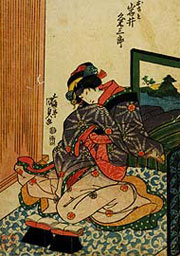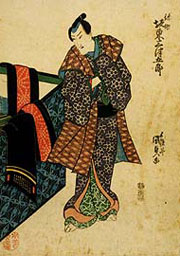| SUSHIYA |
| Play title | Yoshitsune Senbon Zakura Yoshitsune and the Thousand Cherry Trees |
| Authors | Takeda Izumo II Miyoshi Sh˘raku Namiki Senryű I |
| History | The play "Yoshitsune Senbon Zakura" was originally written for the puppet theater (Bunraku) and staged for the first time in the 11th lunar month of 1747 in ďsaka at the Takemotoza. It was adapted for Kabuki the following year and staged for the first time in the 1st lunar month of 1748 in Ise with Kataoka Nizaemon IV (Tokaiya Ginpei, Yokawa no Zenji Kakuhan) and Yamamoto Koheiji (Tadanobu). It was performed for the first time in a city licensed theater in the 5th lunar month of 1748, in Edo at the Nakamuraza [casting]. The "Sushiya" scene was performed with Sawamura Ch˘jűr˘ III, Ichikawa Ebiz˘ II, Nakamura Shichisabur˘ II and Arashi Tominosuke I in the roles of Gonta, Yazaemon, Yasuke and Osato. The first performance in ďsaka was done in the 8th lunar month of 1748, at the Naka no Shibai [casting], and the "Sushiya" scene is performed with Nakamura Utaemon I, Anegawa Shinshir˘ I and Yamatoya Jinbŕ IV in the roles of Gonta, Yazaemon and Yasuke. |
| Structure | The "Sushiya" act, which is nowadays one of the most frequently performed acts of "Yoshitsune Senbon Zakura", is the final scene (kiri) of act III. |
| Key words | Genpei-kassenmono Genji Gidayű Ky˘gen Giri/Ninj˘ Heike Jidaimono Kajiwara Kagetoki Kak˘shű Kiri Kubi Jikken Migawarimono Minamoto Yoritomo Modori Sushiya Tachimawari Teoigoto |
| Summary |
Previous scene: "Kokingo Uchijini" Shimo-Ichimura Tsurubei Sushiya Yazaemon is a devoted supporter of the Heike and it is in Yazaemon's cottage that Koremori, disguised as Yasuke, has found refuge. Yazaemon's daughter, Osato, who does not know Yasuke's real identity, has fallen in love with him. But he is trying to avoid the young woman's attention. Yazaemon's son, Gonta, returning home to squeeze money out of his mother, manages to cheat her and hide the money at the bottom of one of the Sushi tubs. After Gonta disappears, Yazaemon appears, carrying a package with him. It is a human head. Yazaemon sends Koremori, who has come to greet him, on an errand and takes the head from his bundle and pushes it into the sushi tub next to the one where Gonta has hidden the money. When Koremori returns, Yazaemon tells him that a search party is in the village looking for him and suspects his whereabouts. But Yazaemon still hopes to save him. When he came upon the body of a warrior killed in a recent battle, he took the head, hoping to pass it off as Koremori's. When the shop is empty, Gonta creeps out, mistakenly seizes the tub containing the head, and runs off. Osato comes in and prepares a bed by the lamp for her lover, Yasuke, and herself. Yasuke enters and, to Osato's disappointment, makes his bed in the lower room. Koremori's wife and son appear. They are joined by Koremori and relate their several adventures and the dark fate to come. Osato overhears their conversation and realizes that her dream has been in vain. Koremori and his family have hardly left when Kajiwara Kagetoki, a Genji general, stalks into the sushi shop with his men. He has come to demand Koremori's head and is suspicious of Yazaemon. Yazaemon places the tub before him in which he believes the false head to be hidden. His wife, who has watched Gonta steal his father's money and put it in that same tub, does her best to stall. While they are struggling over the tub, Gonta rushes into the shop with the tub containing the head. He offers it for inspection. Seeing the head, Yazaemon thinks that Gonta must have killed Koremori for the sake of the reward, because he still believes that the false head is in his tub. Gonta has brought in a woman and a boy who are bound and gagged, saying they are Koremori's wife and child. Yazaemon is now sure of his son's treachery. Kagetoki inspects the head and declares himself satisfied. He gives a robe to Gonta as a reward for his service. When the soldiers have disappeared, Yazaemon, overcome with horror at his son's treachery, stabs him. Gonta confesses that he overheard his father telling Koremori that the search party was upon them, and his father's loyalty made him deeply ashamed of himself. He was sure Kagetoki would not believe his father, so he had purposely taken the false head. The woman and child, he continues, were his own wife and son whom he sacrificed to save Koremori's family. With his remaining strength Gonta blows a whistle. Hearing it, Koremori and his family come from their hiding place. Koremori unfolds Kagetoki's gift and from it falls a priest gown. They all realize that Kagetoki has not been deceived. To save Koremori, whom he befriended in the old days when he served the Heike, he has accepted the false head, but has sent this hint that it would be safer for Koremori to become a priest. This summary has been written by Watanabe Hisao and edited by Jeff Blair [website] Next scene: "Yoshinoyama" |
| Comments |
Bad characters transformed into heroes--these r˘les appealed to Kabuki audiences. Such was Gonta, a vagabond, a braggart, and a bully, and yet he proves to have a heart of gold. He was ready to bluff a samurai out of his money, swagger boldly, yet shows tenderness for his child, and does not hesitate to sacrifice both wife and offspring when he responds to the clarion call of loyalty. ZoŰ Kincaid in "Kabuki, the Popular Stage of Japan" |
 |
 |
 |
|
The actors Seki Sanjűr˘ II, Iwai Kumesabur˘ II and Band˘ Mitsugor˘ III playing the roles of Gonta, Osato and Yasuke in the "Sushiya" scene of the drama "Yoshitsune Senbon Zakura", which was performed in the 5th lunar month of 1820 in Edo at the Nakamuraza (print made by Utagawa Kunisada I) |
||
|
|
| Contact | Main | Top | Updates | Actors | Plays | Playwrights | Programs | Links | FAQ | Glossary | Chronology | Illustrations | Prints | Characters | Derivatives | Theaters | Coming soon | News |